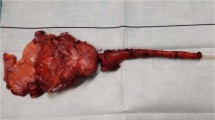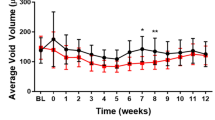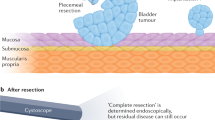Key Points
-
The exact incidence of lower urinary tract dysfunction after treatment of cervical cancer is not known, but it has decreased in the past two decades
-
Frequently occurring urological disorders after radical surgery are hypocontractility of the bladder, detrusor overactivity, incontinence and low-compliance bladder
-
Neuroanatomical knowledge and concomitant nerve-sparing surgery are essential to reduce lower urinary tract dysfunction after radical hysterectomy
-
Radiation-induced urological complications include radiation cystitis, ureteric stenosis, fibrotic, shrunken, low-compliance bladder and fistula formation
-
Owing to the development of image-guided radiotherapy, fewer radiation-induced urological complications have been reported since 1990
Abstract
Several urological complications can occur after treatment of cervical cancer. Stage IB and IIA cervical tumours are mainly treated by radical hysterectomy; advanced-stage tumours are treated by chemoradiotherapy. In the past two decades, a decrease in complications has been seen due to improvements in therapy, although the exact incidence of lower urinary tract dysfunction is unknown. The main urological complications after radical surgery are hypocontractility of the bladder, detrusor overactivity, incontinence, low-compliance bladder, fistula and hydronephrosis. As a result of improved neuroanatomical knowledge, and consequently nerve-sparing surgery, bladder morbidity has been decreasing. Late radiation-induced urological complications include haemorrhagic cystitis, ureteric stenosis, low-compliance bladder and fistulas. Owing to technological improvements, such as dose reduction and decreased radiation fields, a decrease in radiation morbidity has been observed since 1990.
This is a preview of subscription content, access via your institution
Access options
Subscribe to this journal
Receive 12 print issues and online access
$209.00 per year
only $17.42 per issue
Buy this article
- Purchase on Springer Link
- Instant access to full article PDF
Prices may be subject to local taxes which are calculated during checkout



Similar content being viewed by others
References
Hazewinkel, M. H. et al. Long-term cervical cancer survivors suffer from pelvic floor symptoms: a cross-sectional matched cohort study. Gynecol. Oncol. 117, 281–286 (2010).
Piver, M. S., Rutledge, F. & Smith, J. P. Five classes of extended hysterectomy for women with cervical cancer. Obstet. Gynecol. 44, 265–272 (1974).
Mota, F. et al. Classification of radical hysterectomy adopted by the Gynecological Cancer Group of the European Organization for Research and Treatment of Cancer. Int. J. Gynecol. Cancer 18, 1136–1138 (2008).
Querleu, D. & Morrow, C. P. Classification of radical hysterectomy. Lancet Oncol. 9, 297–303 (2008).
Jackson, K. S. & Naik, R. Pelvic floor dysfunction and radical hysterectomy. Int. J. Gynecol. Cancer 16, 354–363 (2006).
Zullo, M. A., Manci, N., Angioli, R., Muzii, L. & Panici, P. B. Vesical dysfunctions after radical hysterectomy for cervical cancer: a critical review. Crit. Rev. Oncol. Hematol. 48, 287–293 (2003).
Possover, M., Stober, S., Plaul, K. & Schneider, A. Identification and preservation of the motoric innervation of the bladder in radical hysterectomy type III. Gynecol. Oncol. 79, 154–157 (2000).
Meigs, J. V. Radical hysterectomy with bilateral pelvic-lymph-node dissection for cancer of the uterine cervix. Clin. Obstet. Gynecol. 1, 1029–1049 (1958).
Raspagliesi, F. et al. Type II versus Type III nerve-sparing radical hysterectomy: comparison of lower urinary tract dysfunctions. Gynecol. Oncol. 102, 256–262 (2006).
Todo, Y. et al. Urodynamic study on postsurgical bladder function in cervical cancer treated with systematic nerve-sparing radical hysterectomy. Int. J. Gynecol. Cancer 16, 369–375 (2006).
van den Tillaart, S. A. et al. Nerve-sparing radical hysterectomy: local recurrence rate, feasibility, and safety in cervical cancer patients stage IA to IIA. Int. J. Gynecol. Cancer 19, 39–45 (2009).
Covens, A. et al. How important is removal of the parametrium at surgery for carcinoma of the cervix? Gynecol. Oncol. 84, 145–149 (2002).
Landoni, F. et al. Class II versus class III radical hysterectomy in stage IB-IIA cervical cancer: a prospective randomized study. Gynecol. Oncol. 80, 3–12 (2001).
Wu, J. et al. Effect of nerve-sparing radical hysterectomy on bladder function recovery and quality of life in patients with cervical carcinoma. Int. J. Gynecol. Cancer 20, 905–909 (2010).
Charoenkwan, K. & Pranpanas, S. Prevalence and characteristics of late postoperative voiding dysfunction in early-stage cervical cancer patients treated with radical hysterectomy. Asian Pac. J. Cancer Prev. 8, 387–389 (2007).
Le, A., Wang, Z., Yuan, R., Xiao, T. & Zhuo, R. Ultrasound urodynamic study of urinary tract dysfunction after radical hysterectomy and pelvic lymphadenectomy in women with cervical carcinoma. Eur. J. Gynaecol. Oncol. 31, 418–424 (2010).
Plotti, F. et al. Update on urodynamic bladder dysfunctions after radical hysterectomy for cervical cancer. Crit. Rev. Oncol. Hematol. 80, 323–329 (2011).
Raspagliesi, F. et al. Nerve-sparing radical hysterectomy in cervical cancer: evolution of concepts. Gynecol. Oncol. 107, S119–S121 (2007).
Benedetti-Panici, P. et al. Long-term bladder function in patients with locally advanced cervical carcinoma treated with neoadjuvant chemotherapy and type 3–4 radical hysterectomy. Cancer 100, 2110–2117 (2004).
Naik, R. et al. Prevalence and management of (non-fistulous) urinary incontinence in women following radical hysterectomy for early stage cervical cancer. Eur. J. Gynaecol. Oncol. 22, 26–30 (2001).
Chuang, T. Y. et al. Neurourological changes before and after radical hysterectomy in patients with cervical cancer. Acta Obstet. Gynecol. Scand. 82, 954–959 (2003).
Chuang, F. C. & Kuo, H. C. Management of lower urinary tract dysfunction after radical hysterectomy with or without radiotherapy for uterine cervical cancer. J. Formos. Med. Assoc. 108, 619–626 (2009).
Chen, G. D., Lin, L. Y., Wang, P. H. & Lee, H. S. Urinary tract dysfunction after radical hysterectomy for cervical cancer. Gynecol. Oncol. 85, 292–297 (2002).
Lin, H. H., Yu, H. J., Sheu, B. C. & Huang, S. C. Importance of urodynamic study before radical hysterectomy for cervical cancer. Gynecol. Oncol. 81, 270–272 (2001).
Oda, Y. et al. Risk factors for persistent low bladder compliance after radical hysterectomy. Int. J. Gynecol. Cancer 21, 167–172 (2011).
Brooks, R. A. et al. Long-term assessment of bladder and bowel dysfunction after radical hysterectomy. Gynecol. Oncol. 114, 75–79 (2009).
Plotti, F. et al. Post radical hysterectomy urinary incontinence: a prospective study of transurethral bulking agents injection. Gynecol. Oncol. 112, 90–94 (2009).
Hamada, K. et al. Urinary disturbance after therapy for cervical cancer: urodynamic evaluation and beta2-agonist medication. Int. Urogynecol. J. Pelvic Floor Dysfunct. 10, 365–370 (1999).
Maman, K. et al. Comparative efficacy and safety of medical treatments for the management of overactive bladder: a systematic literature review and mixed treatment comparison. Eur. Urol. http://dx.doi.org/10.1096/j.eururo.2013.11.010.
Likic, I. S. et al. Analysis of urologic complications after radical hysterectomy. Am. J. Obstet. Gynecol. 199, 644.e1–e3 (2008).
Karkhanis, P., Patel, A. & Galaal, K. Urinary tract fistulas in radical surgery for cervical cancer: the importance of early diagnosis. Eur. J. Surg. Oncol. 38, 943–947 (2012).
Paick, S. H., Oh, S. J., Song, Y. S. & Kim, H. H. The natural history of hydronephrosis after radical hysterectomy with no intraoperatively recognisable injury to the ureter: a prospective study. BJU Int. 92, 748–750 (2003).
Hazewinkel, M. H. et al. Renal ultrasound to detect hydronephrosis: a need for routine imaging after radical hysterectomy? Gynecol. Oncol. 124, 83–86 (2012).
Gellrich, J., Hakenberg, O. W., Oehlschlager, S. & Wirth, M. P. Manifestation, latency and management of late urological complications after curative radiotherapy for cervical carcinoma. Onkologie 26, 334–340 (2003).
Pisarska, M. & Sajdak, S. Lower urinary tract function after postoperative radiotherapy in the treatment of cervical cancer. Eur. J. Gynaecol. Oncol. 24, 490–494 (2003).
Levenback, C., Eifel, P. J., Burke, T. W., Morris, M. & Gershenson, D. M. Hemorrhagic cystitis following radiotherapy for stage Ib cancer of the cervix. Gynecol. Oncol. 55, 206–210 (1994).
McIntyre, J. F., Eifel, P. J., Levenback, C. & Oswald, M. J. Ureteral stricture as a late complication of radiotherapy for stage IB carcinoma of the uterine cervix. Cancer 75, 836–843 (1995).
Lin, H. H., Sheu, B. C., Lo, M. C. & Huang, S. C. Abnormal urodynamic findings after radical hysterectomy or pelvic irradiation for cervical cancer. Int. J. Gynaecol. Obstet. 63, 169–174 (1998).
Biewenga, P. et al. Can we predict vesicovaginal or rectovaginal fistula formation in patients with stage IVA cervical cancer? Int. J. Gynecol. Cancer 20, 471–475 (2010).
Moore, K. N., Gold, M. A., McMeekin, D. S. & Zorn, K. K. Vesicovaginal fistula formation in patients with Stage IVA cervical carcinoma. Gynecol. Oncol. 106, 498–501 (2007).
Fujikawa, K., Miyamoto, T., Ihara, Y., Matsui, Y. & Takeuchi, H. High incidence of severe urologic complications following radiotherapy for cervical cancer in Japanese women. Gynecol. Oncol. 80, 21–23 (2001).
Author information
Authors and Affiliations
Contributions
E.M.K.W. and S.H. contributed to discussions of the content. E.M.K.W. researched the data and wrote the article. E.M.K.W. and S.H. contributed to review and editing of the manuscript before submission.
Corresponding author
Ethics declarations
Competing interests
The authors declare no competing financial interests.
Rights and permissions
About this article
Cite this article
Wit, E., Horenblas, S. Urological complications after treatment of cervical cancer. Nat Rev Urol 11, 110–117 (2014). https://doi.org/10.1038/nrurol.2013.323
Published:
Issue Date:
DOI: https://doi.org/10.1038/nrurol.2013.323
This article is cited by
-
Imaging the post-treatment pelvis with gynecologic cancers
Abdominal Radiology (2024)
-
A visualization analysis of hotspots and global trends on pelvic floor dysfunction in cervical cancer
Journal of Cancer Research and Clinical Oncology (2024)
-
Recently urodynamic and quality of life assessment in the non-menopausal women with cervical cancer after radical hysterectomy
Supportive Care in Cancer (2023)
-
Can preoperative ureteral stents reduce the incidence of ureteral stricture after radiotherapy in patients with cervical cancer?
BMC Urology (2022)
-
Voiding defects in acute radiation cystitis driven by urothelial barrier defect through loss of E-cadherin, ZO-1 and Uroplakin III
Scientific Reports (2021)



